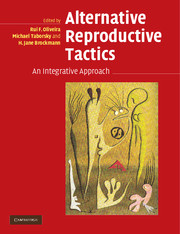Book contents
- Frontmatter
- Contents
- List of contributors
- Preface
- 1 The evolution of alternative reproductive tactics: concepts and questions
- PART I ULTIMATE CAUSES AND ORIGINS OF ALTERNATIVE REPRODUCTIVE TACTICS
- PART II PROXIMATE MECHANISMS OF ALTERNATIVE REPRODUCTIVE TACTICS
- PART III TAXONOMIC REVIEWS OF ALTERNATIVE REPRODUCTIVE TACTICS
- PART IV EMERGING PERSPECTIVES ON ALTERNATIVE REPRODUCTIVE TACTICS
- 16 Communication and the evolution of alternative reproductive tactics
- 17 Alternative mating tactics and mate choice for good genes or good care
- 18 Conflict between the sexes and alternative reproductive tactics within a sex
- 19 Cooperative breeding as an alternative reproductive tactic
- 20 Integrating mechanisms and function: prospects for future research
- Index of species
- Subject index
- References
19 - Cooperative breeding as an alternative reproductive tactic
Published online by Cambridge University Press: 10 August 2009
- Frontmatter
- Contents
- List of contributors
- Preface
- 1 The evolution of alternative reproductive tactics: concepts and questions
- PART I ULTIMATE CAUSES AND ORIGINS OF ALTERNATIVE REPRODUCTIVE TACTICS
- PART II PROXIMATE MECHANISMS OF ALTERNATIVE REPRODUCTIVE TACTICS
- PART III TAXONOMIC REVIEWS OF ALTERNATIVE REPRODUCTIVE TACTICS
- PART IV EMERGING PERSPECTIVES ON ALTERNATIVE REPRODUCTIVE TACTICS
- 16 Communication and the evolution of alternative reproductive tactics
- 17 Alternative mating tactics and mate choice for good genes or good care
- 18 Conflict between the sexes and alternative reproductive tactics within a sex
- 19 Cooperative breeding as an alternative reproductive tactic
- 20 Integrating mechanisms and function: prospects for future research
- Index of species
- Subject index
- References
Summary
CHAPTER SUMMARY
Cooperative breeding, in which more than a pair of individuals cooperates to produce young, is found in a small proportion of birds, mammals, and fishes. Cooperative breeding encompasses a variety of alternative tactics. Some of these, such as mate sharing by males and joint nesting by females, explicitly concern reproduction, while others, such as cooperative courtship and helping at the nest by nonbreeders, involve activities leading to indirect reproduction through kin. In addition to these behavior patterns, cooperative breeding systems less commonly exhibit traditional alternative reproductive tactics (ARTs), including sneaking by males and parasitic egg laying by females. In virtually all cases, cooperative breeding behavior is conditional, facultative, and potentially frequency dependent, at least within groups. However, few attempts have been made to understand the expression or diversity of reproductive tactics observed in cooperative breeding systems using the theoretical framework provided by ART theory. Viewing alternatives as ARTs may help to clarify the selective forces that promote helping at the nest and mate sharing and help to explain the infrequent occurrence of parasitic reproductive behavior patterns in cooperative breeders.
INTRODUCTION
Cooperative breeding is a phenomenon in which more than a pair of individuals shares the tasks of producing young in a single nest or litter. It is known to occur in about 3% of birds and mammals (Brown 1987, Arnold and Owens 1998, Russell 2004), as well as some fishes (Taborsky 1994, 2001), but may be considerably more frequent given that the mating systems of many species remain to be determined (Cockburn 2003).
- Type
- Chapter
- Information
- Alternative Reproductive TacticsAn Integrative Approach, pp. 451 - 470Publisher: Cambridge University PressPrint publication year: 2008
References
- 1
- Cited by



